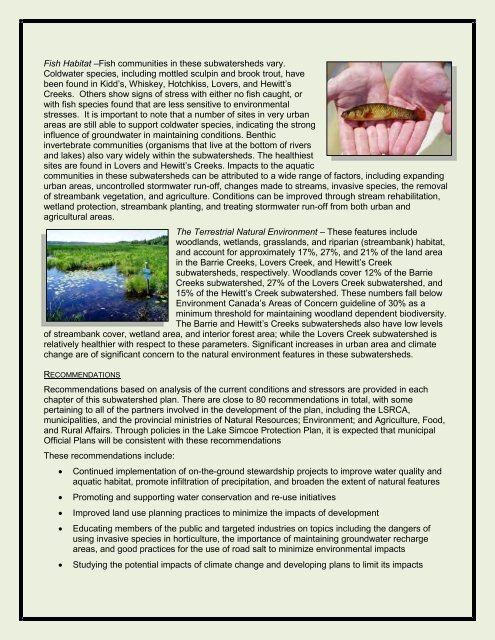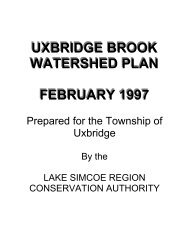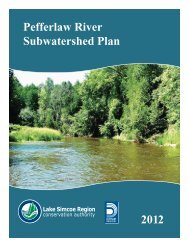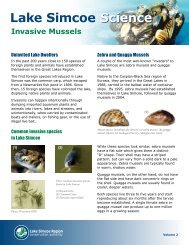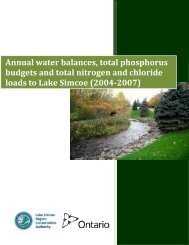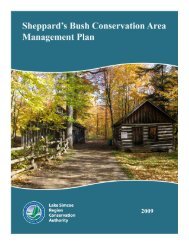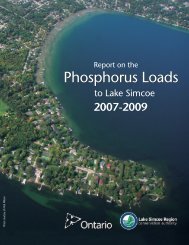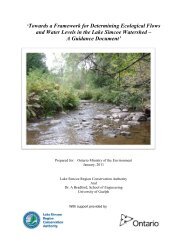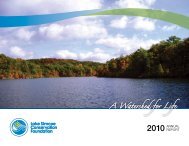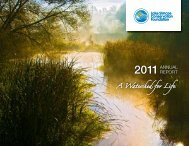Barrie Creeks, Lovers Creek, and Hewitt's Creek Subwatershed Plan
Barrie Creeks, Lovers Creek, and Hewitt's Creek Subwatershed Plan
Barrie Creeks, Lovers Creek, and Hewitt's Creek Subwatershed Plan
Create successful ePaper yourself
Turn your PDF publications into a flip-book with our unique Google optimized e-Paper software.
Fish Habitat –Fish communities in these subwatersheds vary.<br />
Coldwater species, including mottled sculpin <strong>and</strong> brook trout, have<br />
been found in Kidd’s, Whiskey, Hotchkiss, <strong>Lovers</strong>, <strong>and</strong> Hewitt’s<br />
<strong><strong>Creek</strong>s</strong>. Others show signs of stress with either no fish caught, or<br />
with fish species found that are less sensitive to environmental<br />
stresses. It is important to note that a number of sites in very urban<br />
areas are still able to support coldwater species, indicating the strong<br />
influence of groundwater in maintaining conditions. Benthic<br />
invertebrate communities (organisms that live at the bottom of rivers<br />
<strong>and</strong> lakes) also vary widely within the subwatersheds. The healthiest<br />
sites are found in <strong>Lovers</strong> <strong>and</strong> Hewitt’s <strong><strong>Creek</strong>s</strong>. Impacts to the aquatic<br />
communities in these subwatersheds can be attributed to a wide range of factors, including exp<strong>and</strong>ing<br />
urban areas, uncontrolled stormwater run-off, changes made to streams, invasive species, the removal<br />
of streambank vegetation, <strong>and</strong> agriculture. Conditions can be improved through stream rehabilitation,<br />
wetl<strong>and</strong> protection, streambank planting, <strong>and</strong> treating stormwater run-off from both urban <strong>and</strong><br />
agricultural areas.<br />
The Terrestrial Natural Environment – These features include<br />
woodl<strong>and</strong>s, wetl<strong>and</strong>s, grassl<strong>and</strong>s, <strong>and</strong> riparian (streambank) habitat,<br />
<strong>and</strong> account for approximately 17%, 27%, <strong>and</strong> 21% of the l<strong>and</strong> area<br />
in the <strong>Barrie</strong> <strong><strong>Creek</strong>s</strong>, <strong>Lovers</strong> <strong>Creek</strong>, <strong>and</strong> Hewitt’s <strong>Creek</strong><br />
subwatersheds, respectively. Woodl<strong>and</strong>s cover 12% of the <strong>Barrie</strong><br />
<strong><strong>Creek</strong>s</strong> subwatershed, 27% of the <strong>Lovers</strong> <strong>Creek</strong> subwatershed, <strong>and</strong><br />
15% of the Hewitt’s <strong>Creek</strong> subwatershed. These numbers fall below<br />
Environment Canada’s Areas of Concern guideline of 30% as a<br />
minimum threshold for maintaining woodl<strong>and</strong> dependent biodiversity.<br />
The <strong>Barrie</strong> <strong>and</strong> Hewitt’s <strong><strong>Creek</strong>s</strong> subwatersheds also have low levels<br />
of streambank cover, wetl<strong>and</strong> area, <strong>and</strong> interior forest area; while the <strong>Lovers</strong> <strong>Creek</strong> subwatershed is<br />
relatively healthier with respect to these parameters. Significant increases in urban area <strong>and</strong> climate<br />
change are of significant concern to the natural environment features in these subwatersheds.<br />
RECOMMENDATIONS<br />
Recommendations based on analysis of the current conditions <strong>and</strong> stressors are provided in each<br />
chapter of this subwatershed plan. There are close to 80 recommendations in total, with some<br />
pertaining to all of the partners involved in the development of the plan, including the LSRCA,<br />
municipalities, <strong>and</strong> the provincial ministries of Natural Resources; Environment; <strong>and</strong> Agriculture, Food,<br />
<strong>and</strong> Rural Affairs. Through policies in the Lake Simcoe Protection <strong>Plan</strong>, it is expected that municipal<br />
Official <strong>Plan</strong>s will be consistent with these recommendations<br />
These recommendations include:<br />
• Continued implementation of on-the-ground stewardship projects to improve water quality <strong>and</strong><br />
aquatic habitat, promote infiltration of precipitation, <strong>and</strong> broaden the extent of natural features<br />
• Promoting <strong>and</strong> supporting water conservation <strong>and</strong> re-use initiatives<br />
• Improved l<strong>and</strong> use planning practices to minimize the impacts of development<br />
• Educating members of the public <strong>and</strong> targeted industries on topics including the dangers of<br />
using invasive species in horticulture, the importance of maintaining groundwater recharge<br />
areas, <strong>and</strong> good practices for the use of road salt to minimize environmental impacts<br />
• Studying the potential impacts of climate change <strong>and</strong> developing plans to limit its impacts


